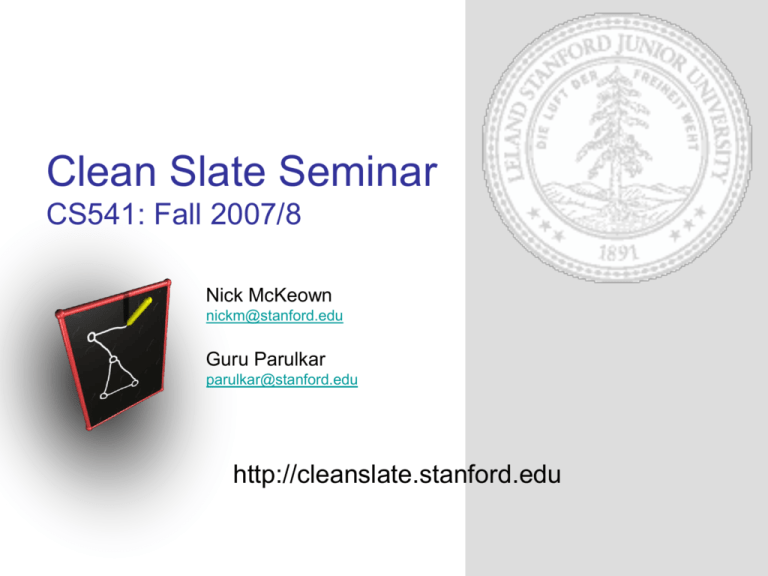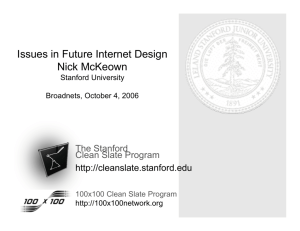Clean Slate Design for the Internet
advertisement

Clean Slate Seminar CS541: Fall 2007/8 Nick McKeown nickm@stanford.edu Guru Parulkar parulkar@stanford.edu http://cleanslate.stanford.edu Outline What is clean-slate research? Stanford’s Clean Slate Program Logistics for CS541 – Schedule for the quarter – What we expect from you CS541: Clean Slate Research http://cleanslate.stanford.edu Anything to rethink? Well-known researcher in mid-1990s: “Multimedia communications over the Internet is done.” “How come it takes an hour to set up a session?” “Why can I join someone else’s call?” “Will the quality always be this poor?” “Can I put a camera on my car and drive around?” CS541: Clean Slate Research http://cleanslate.stanford.edu Story The Internet enabled universal communications and transformed society Other infrastructure technologies have had big impact (e.g. electrification, water supply and distribution, highways/cars, radio & TV, telephone) All have changed enormously over time … except the Internet The Internet infrastructure will change The only question is how. CS541: Clean Slate Research http://cleanslate.stanford.edu The Internet Hourglass Applications Kazaa VoIP Mail TCP News Video Audio IM YouTube Everything Transport protocols on IP SCTP UDP ICMP IP Ethernet 802.11 IP on Power lines ATM Optical everything Satellite Bluetooth Link technologies CS541: Clean Slate Research Modified John Doyle Slide http://cleanslate.stanford.edu Internet and WEB Hourglass Kazaa VoIP Mail Applications Everything Newson Video WEB Audio IM YouTube HTTP Little change Transport protocols TCP SIP UDP RTP Continued Innovations IP Ethernet 802.11 on Power lines IP ATM CS541: Clean Slate Research everything Optical Satellite Bluetooth Modified John Doyle Slide http://cleanslate.stanford.edu Internet Technology Innovations Optical transmission and WDM Packet switching Wireless and mobile networking Internetworking architecture Routers, switches, security devices, routing systems Domain name system Client/server architectures and applications HTTP, browsers, servers Search engines, targeted advertisements P2P technologies and applications And many more CS541: Clean Slate Research http://cleanslate.stanford.edu Internet Architecture Limitations Security & robustness - to support other critical infrastructures Control and management Addressing, naming & (inter-domain) routing End-to-end principle vs in-network processing Mobility of hosts and networks Economic viability of different stakeholders CS541: Clean Slate Research http://cleanslate.stanford.edu State of Internet “… in the thirty-odd years since its invention, new uses and abuses, …, are pushing the Internet into realms that its original design neither anticipated nor easily accommodates.” “Freezing forevermore the current architecture would be bad enough, but in fact the situation is deteriorating. These architectural barnacles—unsightly outcroppings that have affixed themselves to an unmoving architecture— may serve a valuable short-term purpose, but significantly impair the longterm flexibility, reliability, security, and manageability of the Internet.” Overcoming Barriers to Disruptive Innovation in Networking, NSF Workshp Report, 05. CS541: Clean Slate Research http://cleanslate.stanford.edu Unthought of applications Economically sustainable Trustworthy: Secure, robust, manageable Mobility by default. Users and data Performance to blow our socks off Unthought of links CS541: Clean Slate Research http://cleanslate.stanford.edu A Research Problem, or A Problem with Research? Cultural problem – Research community was stuck in incrementalism and backward compatibility – Researchers need to ask hard and unpopular questions – Compatibility with reputation and career prospects…? Yet, radical approaches are common in other fields Is it just a problem of installed base? CS541: Clean Slate Research http://cleanslate.stanford.edu Rethinking the car Installed base 1 gallon of gas g 22lbs of CO2 1900 1968 2007 8,000 170M 700M Car Engine Control Fuel Car Body Materials Manufacture Safety CS541: Clean Slate Research Policy Emissions Fueling Stations http://cleanslate.stanford.edu General Approach in Research Community 1. Build a nationwide research facility upon which new architectures can be tested – NSF GENI Program http://www.geni.net – Key concept: Virtualization to support multiple architectures simultaneously. 2. Deploy and test experimental architectures CS541: Clean Slate Research http://cleanslate.stanford.edu Conception-to-Deployment Case for GENI Facility Maturity Need for Large experimental facility/infrastructure Shared Deployed Infrastructure This chasm represents a major barrier to impact real world Small Scale Testbeds Research Prototypes Foundational Research Time CS541: Clean Slate Research http://cleanslate.stanford.edu Facility Design: Key Concepts Sensor Network Edge Site Mobile Wireless Network Federated Facilities Slicing, Virtualization, Programmability CS541: Clean Slate Research http://cleanslate.stanford.edu The Stanford Clean Slate Program Approach Motivating Questions “How will the Internet look in 15-20 years?” “With what we know today, if we started with a clean-slate, how would we design a new Internet?” Bring together Stanford’s breadth and depth: Networking, optical communications, wireless, access networks, theory, economics, security, applications, multimedia, operating systems, hardware and VLSI, system architecture, … Research for long term impact on the practice of networking Two pronged approach: “innovations in the small” and “innovations in the large” CS541: Clean Slate Research http://cleanslate.stanford.edu Broad Interdisciplinary Focus Heterogeneous Applications Security Robustness Network Architectures Economics Policies Heterogeneous PHY Technologies CS541: Clean Slate Research http://cleanslate.stanford.edu Clean Slate Program Approach “Innovation in the small” Architectural Start many small exploratory projects Blueprint? Lots of new ideas Lots of areas CS541: Clean Slate Research http://cleanslate.stanford.edu Clean Slate Approach Cont “Innovation in the large” Architectural Start a few select larger collaborative projects Teams of students, faculty and industry Blueprint? CS541: Clean Slate Research http://cleanslate.stanford.edu Clean Slate Approach Security Backbone (Lightflow) Wireless Network Virtualization Flow Control/Security Cheap Backbone Congestion Wireless Theory (Ethane) Prog H/W (VLB) Control (Spectrum) (NetFPGA) (RCP) CS541: Clean Slate Research http://cleanslate.stanford.edu Example projects 1. 2. 3. 4. “If we started over, how could we design a more secure network?” “How could we design a network good enough for tele-surgery?” “What is the economic/business model that will lead to multiple, concurrent virtualized networks?” “What platforms facilitate others to do clean-slate research?” CS541: Clean Slate Research http://cleanslate.stanford.edu Example Project Facilitating others Programmable building blocks XORP: Software, extensible, open-source WARP: Programmable wireless MACs WUSTL Programmable router NetFPGA: Programmable network hardware CS541: Clean Slate Research http://cleanslate.stanford.edu Outline What is clean-slate research? Stanford’s Clean Slate Program Logistics for CS541 – Schedule for the quarter – What we expect from you CS541: Clean Slate Research http://cleanslate.stanford.edu CS541: Schedule for Quarter Week 2 (Oct 2) “GENI Research Rationale” Ellen Zegura, Georgia Tech, Co-Chair GENI Science Council Week 3 (Oct 9) “GENI Research Rationale for Reinventing the Internet” Stanford Faculty Panel Week 4 (Oct 16) TBA Week 5 (Oct 23) James Kempf (DoCoMo Labs) + Student Panel Week 6 (Oct 30) “Mobile Wireless and Its Implications on Future” D. Raychaudhuri, Rutgers, Co-Chair of GENI Mobile Wireless Working Group Week 7 (Nov 6) “Data Center Architectures” Alan Berstein, Credit Suisse Week 8 (Nov 13) TBA Week 9 (Nov 20) “Distributed Systems and Future Internet” Frans Kaashoek, MIT Week 10 (Nov 27 or Dec 4) “Distributed Services for GENI” Amin Vahdat, University of California San Diego. CS541: Clean Slate Research http://cleanslate.stanford.edu Format for talks and panels 4 – 4.15pm: Refreshments 4.15 – 5.15pm: Guest speaker 5.15 - 6pm: Reverse Panel Student panel questions our guest speaker CS541: Clean Slate Research http://cleanslate.stanford.edu What we expect from you If you are taking for credit… Attend every week (you are allowed to miss one) Write a 5-page report on a clean-slate topic, agreed with instructors, or Take part in student panel CS541: Clean Slate Research http://cleanslate.stanford.edu





